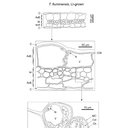Oxygen as an alternative electron acceptor in the photosynthetic electron transport chain of C3 plants.
Nøkkelord
Abstrakt
This study deals with effects of oxygen on the kinetics of P(700) photoinduced redox transitions and on induction transients of chlorophyll fluorescence in leaves of C(3) plants Hibiscus rosa-sinensis and Vicia faba. It is shown that the removal of oxygen from the leaf environment has a conspicuous effect on photosynthetic electron transport. Under anaerobic conditions, the concentration of oxidized P700 centers in continuous white light was substantially lower than under aerobic conditions. The deficiency of oxygen released non-photochemical quenching of chlorophyll fluorescence, thus indicating a decrease in the trans-thylakoid pH gradient (DeltapH). Quantitative analysis of experimental data within the framework of an original mathematical model has shown that the steady-state electron flux toward oxygen in Chinese hibiscus leaves makes up to approximately 40% of the total electron flow passing through photosystem 1 (PS1). The decrease in P700+ content under anaerobic conditions can be due to two causes: i) the retardation of electron outflow from PS1, and ii) the release of photosynthetic control (acceleration of electron flow from PS2 to P700+) owing to lower acidification of the intra-thylakoid space. At the same time, cyclic electron transport around PS1 was not stimulated in the oxygen-free medium, although such stimulation seemed likely in view of possible rearrangement of electron flows on the acceptor side of PS1. This conclusion stems from observations that the rates of P700+ reduction in DCMU-poisoned samples, both under aerobic and anaerobic conditions, were negligibly small compared to rates of electron flow from PS2 toward P700+ in untreated samples.


